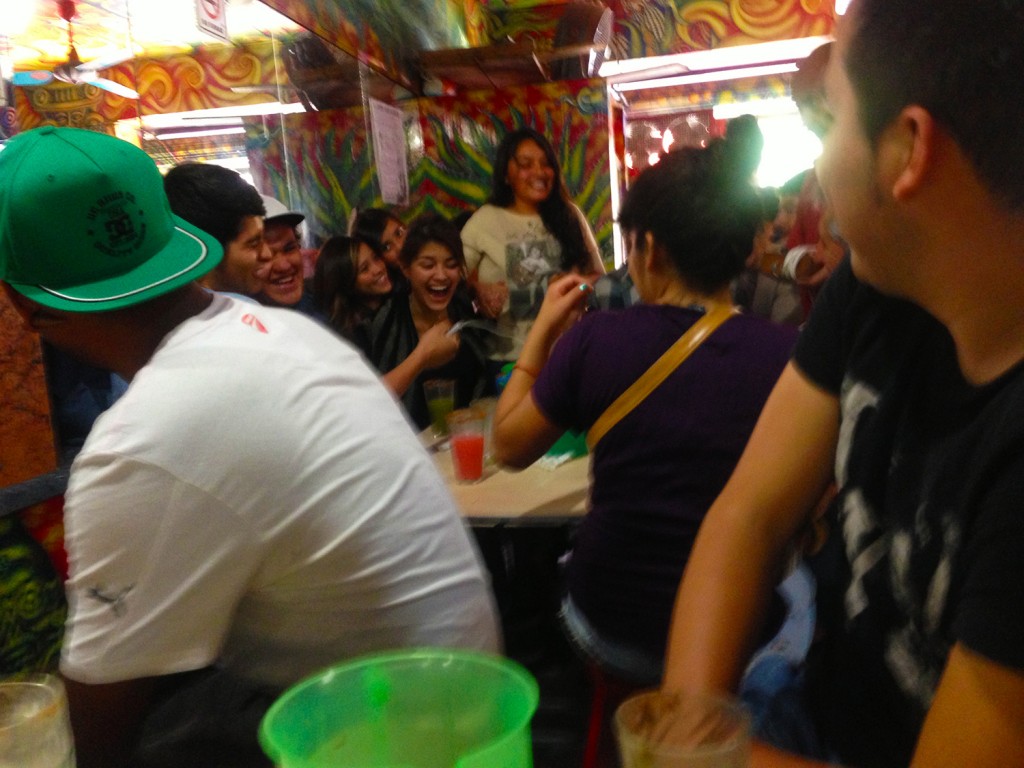 A flight of pulque. Clockwise from the top: oatmeal, guava, lime, celery, mango, and plain in the center.
A flight of pulque. Clockwise from the top: oatmeal, guava, lime, celery, mango, and plain in the center.
We were way too old to be in this place. We were definitely the creepy old couple. Looking around the bar, most of the people drinking around us looked to be in their early twenties, and perhaps younger: the drinking age in Mexico is 18, after all. And more than that, there was a youthful rebelliousness in this crowd seldom seen Mexico City: in general mild temperatures and Catholicism resulted in conservative dress. But in the pulqueria, facial piercings were the norm, women bared their shoulders, and one crusty punkette asked if we would like to buy a pot brownie (brownie de cannabis).
My husband and I were recently married (late in life, by some standards, at the ages of 30 and 31) and honeymooning in Mexico City, when curiosity led us to a Pulqueria. Pulque is an ancient drink made from the fermented sap of the agave; it is thought to have been developed at least 2,000 years ago. Distill that juice, and you get tequila (or mezcal); ferment it like beer, and you get pulque, thick and milky white. A staple of Aztec life, for many years it survived as a drink of the working class; but recently, pulque has been receiving press for its growing popularity amongst Mexico City’s youth.
 A 1,000 year old mural depicted people drinking pulque. (source)
A 1,000 year old mural depicted people drinking pulque. (source)
The Pulqueria La Risa, where we sat, has been pouring the thick beverage for over a century. In the modern incarnation of this drink, fruit juices, or nuts and grains along with sugar are added. On the day we visited, the sabores de dia included Guava, Mango, Celery, Blackberry, Oatmeal, and Pine Nut. In its pure state, I found pulque to taste like stomach acid, so the addition of sweet fruit juice is a huge improvement. The result is something like a wine cooler: sweet in flavor, but with an ABV on level with a beer.
 Inside Pulqueria La Risa.
Inside Pulqueria La Risa.
I think it’s wine cooler-like qualities are responsible for its resurgence amongst the young. The drink is even beginning to make its way to New York City; Pulqueria, in lower Manhattan, offers ginger-peach and tomatillo pulques alongside a full Mexcian menu. A glass of pulque costs $14, about ten times the going price in Mexico city.
Do I think pulque will be a huge hit north of the border? Not likely. After carving out a small corner in the densely packed bar, my husband and I ordered a pitcher of oatmeal pulque. Sweetened and topped with cinnamon, its the breakfast that gets you drunk. We had planned to order several pitchers, and perhaps a discrete, foam, to-go cup, and get slowly drunk on a hot afternoon. But after the first pitcher, our stomachs were full and grossly distended. Pulque is often known as a meal in a glass, packed full of calories and vitamins, and is incredibly filling. We left, sober and gassy, and fairly confident that that was the first, and last time, we’d try to get drunk on pulque.

As a graduation-from-high school gift, my parents sent me to Ecuador for a week. One of the gifts I brought home was a small bottle of pulque — no problem getting it into the country in 1970. My father, who was interested in unusual cocktails, did try to make it into something interesting enough to drink, but I don’t think he ever succeeded to his satisfaction.
The liquid in the bottle was a slightly dirty-looking, cloudy, watery substance. I wasn’t allowed to drink any — not old enough in the U.S. — but it smelled to me like slightly dirty water. I’ve never been tempted to drink any.
We tried bottled pulque when we were in Sunnyside, WA for a funeral. At our hotel after, we wanted something to drink, so walked to the local mostly-hispanic grocery store. We got a six of the nearest thing to microbrew they had, then noticed the pulque and bought a six of that. Pulque la Lucha it was called, and I think we tried the pina-coco flavor. It was nasty.
We brought the remaining 5 bottles home and gave them to our pigs. They didn’t seem to mind the taste, and copped a nice buzz :)
I’ve never tried the bottles or cans of pulque; I was surprised to even see there was such a thing. Apparently, the fermentation of the agave sap starts almost as soon as you scoop it out of the plant, and there’s no way to stop it. The pulque in the pulqueria is very fresh; they have it for a few days, and then it reaches a point where it can’t be served any at all. I don’t know what happens at the point–wether its too boozey, or not boozey at all, or too sour or what. But they chuck it.
So considered that policy, of the pulque only being just right for a few days, I can’t imagine what they put into canned pulque to stabilize it.
So if you ever get the chance to try to fresh stuff, I recommend the experience!
I lived in DF for a whileand consumed my fair share of pulque. It takes a while to get past that “do I like this or hate this?” stage, but when you are over the hump there is no going back.
It is very filling, but I did enjoy the variety of flavors.